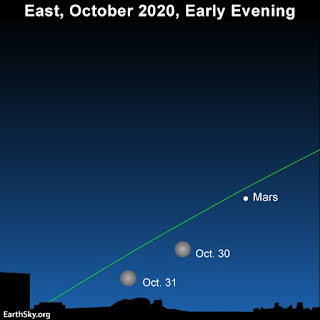You knew this year was odd, in so many ways.
Even the heavens are screaming out the message.
And tonight, you will be able to view an extraordinarily unusual event as the moon rises around 6:17 PM PDT: a blue moon, a hunter's moon and a micro-moon, ALL on a day signaling the supernatural: Halloween. Even rarer, this odd apparition will be viewable across all four time zones of the U.S. And even more ominous, a blood-red Mars will be close to the moon.
More amazing, the skies will clear over the Northwest for a good view.
Be scared, very scared.
Let's begin with the weather situation. It is nearly clear outside this morning around the Northwest, with very thin cirrus and some fog in local river valleys (see below).
The full moon tonight will be a BLUE MOON, which occurs when there are two full moons in a month. Blue moons are not that rare, occurring every 2-3 years.
But this will be Blue Moon on Halloween, which occurs roughly every 19 years. More unusual.
But this Blue Moon will also be a micro-moon (also known as a mini-moon), in which the moon is at its farthest distance from the earth.
The moon's orbit around the Earth is an ellipse, not a circle, and at its farthest distance (the apogee) it looks smaller (see a comparison in size between a supermoon, where the moon is close to the earth, and a micromoon, below).
And on top of it all, this blue moon will be viewable in all time zones of the U.S., which is often not true.
Want more? Mars is very close to Earth and tonight will be seen just above the moon (see below). A large blood-red Mars on Halloween.
Put all of these exceptional circumstances together, and tonight will be an astronomical treat you will not see again in your lifetime.
And to make this even odder, nearly the entire U.S. will have clear or nearly clear skies tonight, something suggested by the latest visible satellite image from the GOES-East weather satellite:
The full moon tonight will be a Hunter's Moon, the first full moon after the Harvest Moon, which is the full moon closest to the autumnal equinox (Sept. 21).
I will not even consider the political implications of this convergence of unusual events.





































